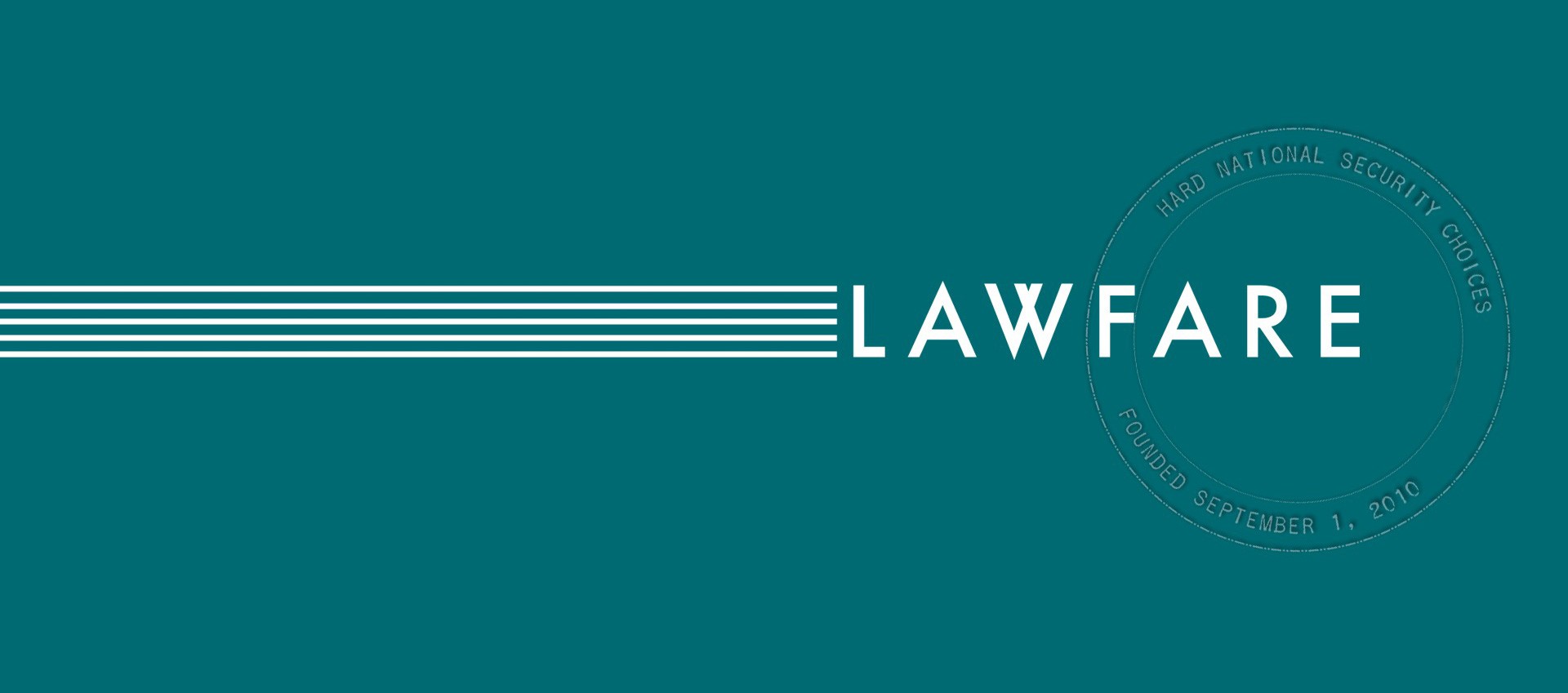The Draft, the Constitutional Militia, and the Most Important Supreme Court NSL Case You (Probably) Haven't Heard Of...
According to various media reports, General Stanley McChrystal suggested late last month that the United States should bring back the draft if it goes to war again, arguing that the costs of the wars in Iraq and Afghanistan have not been adequately spread across different segments of the U.S. population...
Published by The Lawfare Institute
in Cooperation With

According to various media reports, General Stanley McChrystal suggested late last month that the United States should bring back the draft if it goes to war again, arguing that the costs of the wars in Iraq and Afghanistan have not been adequately spread across different segments of the U.S. population... Without delving into the merits of General McChrystal's remarks as a policy matter, they present a useful opportunity to reflect on one of the most significant Supreme Court national security decisions that few of us have ever heard about: The Court's 1918 decision in Arver (et al.) v. United States, the so-called "Selective Draft Law Cases." Although the Selective Draft Law Cases did not settle every constitutional question with regard to the validity of a draft, it did resolve what, in my view at least, was the strongest textual/structural argument against it--as I explain below the fold.
From the outset, it bears emphasizing that the Constitution specifically contemplates the enlistment of at least some segments of the population at large to respond to certain military emergencies. After all, the Calling Forth Clause of Article I empowers Congress "To provide for calling forth the Militia to execute the Laws of the Union, suppress Insurrections and repel Invasions." And it was well understood at the Founding that the Constitution's references to the "Militia" was not to what we today think of as the various state National Guard units, but rather the able-bodied (male) population at large. Thus, it was the public at large, and not a standing army, that was tasked with responding to the three most significant categories of domestic emergencies. Moreover, as Justice Jackson wrote in Youngstown, "Such a limitation on the command power, written at a time when the militia rather than a standing army was contemplated as the military weapon of the Republic, underscores the Constitution’s policy that Congress, not the Executive, should control utilization of the war power as an instrument of domestic policy."
To that end, Congress relied on its power under the Calling Forth Clause to pass a series of early statutes, including that on which President Washington relied in putting down the Whiskey Rebellion. And although Congress increasingly (and controversially) came to authorize use of the federal regulars in situations that the Constitution appeared to reserve for the "Militia," the statutes continued to authorize the calling forth of the militia at large through the organization of the modern National Guard system in the early 1900s.
Separate from the question whether federal regulars could be used in situations in which the Constitution appeared to contemplate resort to the militia (a constitutional issue the Supreme Court has never squarely confronted), the flip-side of that same coin was whether the militia could be "called out" in circumstances other than those expressly authorized by Article I, i.e., "to execute the Laws of the Union, suppress Insurrections, and repel Invasions." Understandably, this issue did not arise until the First World War--the first time Congress authorized a draft for purposes of fighting a foreign war. And so the question the Court was asked to decide in Arver was the constitutionality of the 1917 Selective Draft Law, which subjected "all male citizens between the ages of twenty-one and thirty to duty in the national army for the period of the existing emergency after the proclamation of the President announcing the necessity for their service."
Writing for a unanimous Court, Chief Justice White upheld the Selective Draft Law as a valid exercise of Congress's Article I power to raise armies. In his words, "As the mind cannot conceive an army without the men to compose it, on the face of the Constitution the objection that it does not give power to provide for such men would seem to be too frivolous for further notice." As for the argument that the Calling Forth Clause necessarily limited Congress's power under the Raise Armies Clause, Chief Justice White replied:
because under the express regulations the power was given to call [the militia] for specified purposes without exerting the army power, it cannot follow that the latter power when exerted was not complete to the extent of its exertion and dominant. Because the power of Congress to raise armies was not required to be exerted to its full limit but only as in the discretion of Congress it was deemed the public interest required, furnishes no ground for supposing that the complete power was lost by its partial exertion. Because, moreover, the power granted to Congress to raise armies in its potentiality was susceptible of narrowing the area over which the militia clause operated, affords no ground for confounding the two areas which were distinct and separate to the end of confusing both the powers and thus weakening or destroying both.As I've written elsewhere, "In other words, although the Calling Forth Clause did limit the circumstances in which the militias could be used, it did not thereby also limit those situations where civilians drafted into the regular federal army could be used. Instead, Congress’s power to institute a draft derived from its power to raise armies, and the Calling Forth Clause did not provide an independent substantive limit on when and where those armies could be employed." Indeed, as a unanimous Court would summarize this holding four months later in Cox v. Wood, "the authority in the exercise of the war power to raise armies and use them when raised was not subject to limitations as to use of the militia, if any, deduced from the militia clause." On its face, I'm not sure that this is the most compelling argument, for it appears to allow for the Raise Armies Clause to swallow the Calling Forth Clause. To be sure, there is still an important distinction with regard to the status of the individual soldiers: when militiamen are "called forth" pursuant to statutes enacted under the Calling Forth Clause, they are still technically militiamen, and not federal regulars. [This distinction is reflected in, inter alia, the Fifth Amendment's Grand Jury Indictment Clause, the exception to which applies to "cases arising in the land or naval forces, or in the Militia, when in actual service in time of War or public danger."] In contrast, when civilians are drafted into the army, they become federal regulars despite the fact that they didn't volunteer for such service. Nevertheless, if the Raise Armies Clause allows Congress to conduct a draft for any purpose it deems appropriate (since it itself contains no substantive constraints on the use of such armies), then nothing other than political considerations (and perhaps the Due Process Clause) prevents Congress from simply "raising an army" to respond even to the three categories of domestic crises for which the Constitution appears to prefer the militia--let alone to overseas crises. Put another way, there's no reason for Congress to ever provide for calling forth the militia anymore, if it can effect the exact same result (with fewer constraints) through the Raise Armies Clause. And lest you think this is merely an academic diversion, this exact logic helps to explain the constitutional status of today's National Guard. As Justice Stevens explained in Perpich v. Dep't of Defense in 1990, although the various state Guard units are the constitutional militia when acting in their purely state capacity, by statute, they become federal regulars--and not called forth militia--when they are "called up." [In Perpich, this explained why federalized Guard units could be deployed for purposes other than the three situations delineated in the Calling Forth Clause.] Thus, for better or worse, the logic of the Selective Draft Law Cases appeared to justify Congress relying on its power to raise armies rather than its power to call forth the militia whenever military force was needed, including in the domestic emergency situations contemplated by the Calling Forth Clause. To be sure, that Congress acted this way was a development that long-predated the 1918 Supreme Court decision (as my Note explained, it began in earnest in 1807). But it was the Selective Draft Law Cases that provided the rationale for such a textual move--and that thereby opened the door to the effective mooting of the Calling Forth Clause as a relevant limit on Congress's constitutional power.
Steve Vladeck is a professor of law at the Georgetown University Law Center. A 2004 graduate of Yale Law School, Steve clerked for Judge Marsha Berzon on the Ninth Circuit and Judge Rosemary Barkett on the Eleventh Circuit. In addition to serving as a senior editor of the Journal of National Security Law & Policy, Steve is also the co-editor of Aspen Publishers’ leading National Security Law and Counterterrorism Law casebooks.




